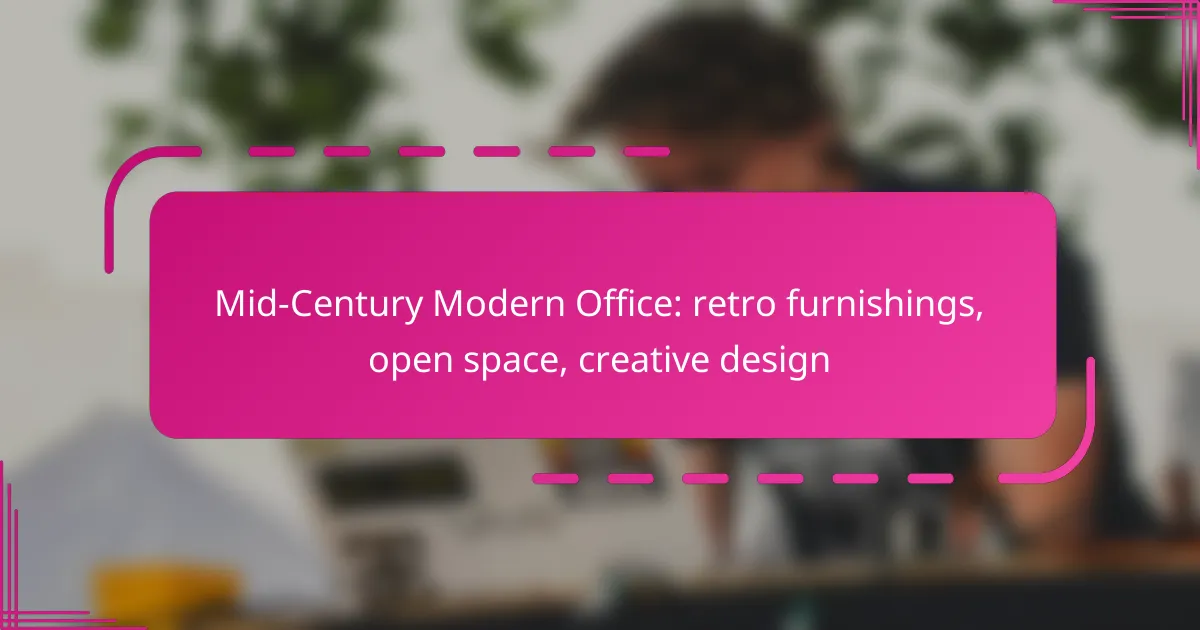Creating a Mid-Century Modern office space seamlessly integrates retro furnishings with innovative design principles. By emphasizing open layouts and iconic pieces from renowned brands, such as Herman Miller and Knoll, you can foster a creative and inspiring work environment that balances aesthetics with functionality.
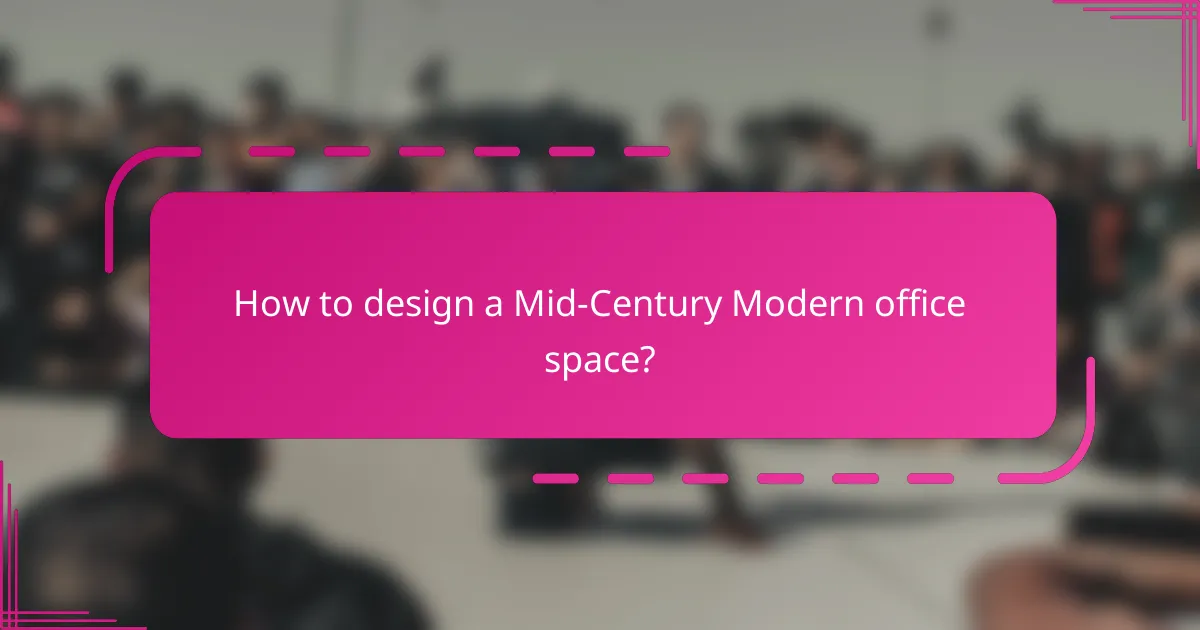
How to design a Mid-Century Modern office space?
Designing a Mid-Century Modern office space involves blending retro aesthetics with functional design. Focus on iconic furniture, open layouts, and natural elements to create an inspiring work environment.
Incorporate iconic furniture pieces
To achieve a Mid-Century Modern look, select furniture that features clean lines and organic shapes. Key pieces include Eames chairs, Noguchi tables, and teak desks, which embody the era’s emphasis on form and function.
Consider investing in vintage or high-quality reproductions to maintain authenticity. Mixing these iconic pieces with contemporary elements can create a balanced and stylish workspace.
Utilize open floor plans
An open floor plan is essential for a Mid-Century Modern office, promoting collaboration and flexibility. Aim for a layout that minimizes barriers, allowing for easy movement and communication among team members.
When designing the space, consider using modular furniture that can be rearranged as needed. This adaptability supports a dynamic work environment while maintaining the aesthetic appeal of the Mid-Century style.
Emphasize natural light
Natural light is a hallmark of Mid-Century Modern design, enhancing the overall atmosphere of the office. Maximize daylight by incorporating large windows, skylights, or glass partitions that blur the lines between indoor and outdoor spaces.
Position workstations near windows to take advantage of sunlight, and use light, airy window treatments to maintain brightness without sacrificing privacy. This approach not only improves mood but also boosts productivity.
Choose a muted color palette
A muted color palette is characteristic of Mid-Century Modern design, featuring earthy tones and soft pastels. Opt for colors like olive green, mustard yellow, and warm browns to create a calming and cohesive environment.
Consider using these colors on walls, furniture, and accessories to maintain a unified look. Avoid overly bright or clashing colors, as they can detract from the serene atmosphere typical of this design style.
Integrate organic materials
Incorporating organic materials is crucial for a Mid-Century Modern office, as it connects the interior with nature. Use wood, leather, and stone to create a warm and inviting space that reflects the era’s appreciation for natural elements.
Choose sustainable materials whenever possible, such as reclaimed wood or eco-friendly textiles, to enhance the office’s aesthetic while promoting environmental responsibility. This approach aligns with the Mid-Century ethos of simplicity and functionality.
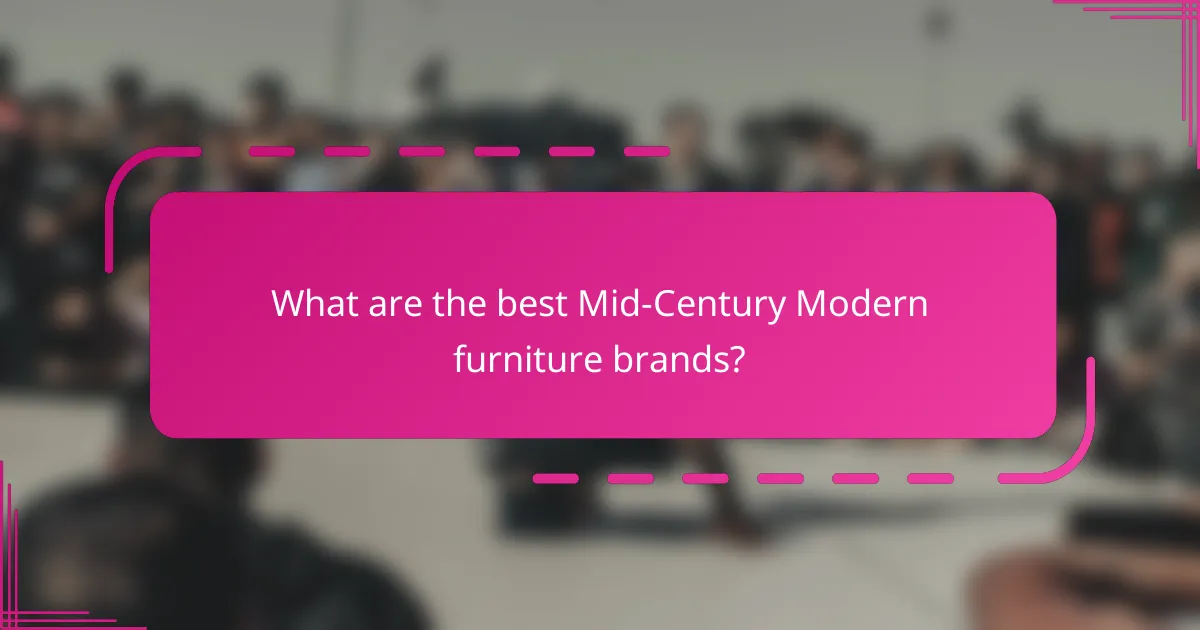
What are the best Mid-Century Modern furniture brands?
The best Mid-Century Modern furniture brands combine retro aesthetics with functional design, offering pieces that enhance open office spaces. Notable brands include Herman Miller, Knoll, West Elm, and CB2, each known for their unique contributions to this iconic style.
Herman Miller
Herman Miller is renowned for its innovative designs and quality craftsmanship in Mid-Century Modern furniture. Their pieces, such as the Aeron chair and Eames lounge chair, are not only stylish but also ergonomic, making them ideal for office environments.
When selecting Herman Miller products, consider their sustainability practices, as many items are made from recycled materials. Investing in their furniture often means a higher upfront cost, but the durability and timeless design can justify the expense over time.
Knoll
Knoll is another leading brand in Mid-Century Modern design, known for its collaboration with iconic designers like Ludwig Mies van der Rohe and Eero Saarinen. Their furniture often features clean lines and functional forms, perfect for creating a sophisticated office atmosphere.
Knoll’s products tend to be on the higher end of the price spectrum, reflecting their quality and design pedigree. It’s advisable to explore their range of modular systems, which can be tailored to fit various office layouts and needs.
West Elm
West Elm offers a more accessible entry point into Mid-Century Modern design, featuring a variety of furniture pieces that blend retro style with contemporary trends. Their collections often include desks, chairs, and storage solutions that are both functional and aesthetically pleasing.
While West Elm products are generally more affordable, be mindful of the materials used, as some may not offer the same longevity as higher-end brands. Look for items that emphasize solid wood and durable finishes for better investment value.
CB2
CB2, a sister brand to Crate and Barrel, focuses on modern design with a youthful twist, making it a popular choice for those seeking Mid-Century Modern furniture at competitive prices. Their offerings include sleek desks and stylish seating options that suit a variety of office styles.
CB2’s furniture often features bold colors and innovative materials, appealing to a younger demographic. However, it’s essential to check the quality and durability of specific items, as some may prioritize style over long-term use.
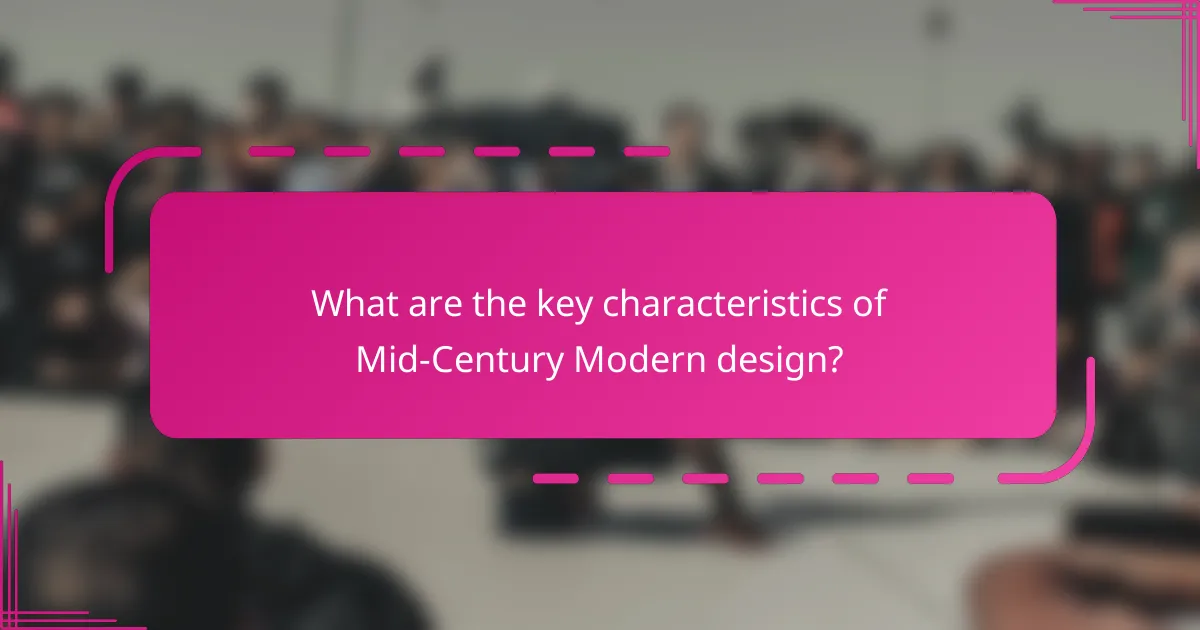
What are the key characteristics of Mid-Century Modern design?
Mid-Century Modern design is characterized by its emphasis on simplicity, functionality, and a connection to nature. This style blends sleek aesthetics with practical elements, creating spaces that are both visually appealing and efficient.
Sleek lines and organic shapes
Sleek lines and organic shapes are hallmarks of Mid-Century Modern design, promoting a sense of fluidity and openness. Furniture often features clean, geometric forms that contrast with softer, rounded edges, creating a harmonious balance.
When selecting furnishings, look for pieces that embody these characteristics, such as low-profile sofas with tapered legs or sculptural chairs. These elements not only enhance visual appeal but also contribute to an airy atmosphere in office spaces.
Functional and minimalist aesthetics
The functional and minimalist aesthetics of Mid-Century Modern design prioritize practicality without sacrificing style. This approach encourages the use of multi-functional furniture, such as desks with built-in storage or modular seating arrangements.
To achieve this look, choose furnishings that serve a purpose while maintaining a streamlined appearance. Avoid overcrowding the space with unnecessary items, focusing instead on a few key pieces that reflect the design ethos.
Use of bold colors and patterns
Bold colors and patterns play a significant role in Mid-Century Modern design, adding vibrancy and personality to spaces. Common color palettes include rich hues like mustard yellow, teal, and avocado green, often paired with neutral tones to balance the overall look.
Incorporate these colors through accent walls, artwork, or decorative accessories. Patterns, such as geometric prints or abstract designs, can be introduced via textiles like rugs or cushions, enhancing the creative vibe of the office environment.

How to choose the right furnishings for a Mid-Century Modern office?
Selecting the right furnishings for a Mid-Century Modern office involves focusing on simplicity, functionality, and a blend of retro aesthetics. Prioritize pieces that enhance open spaces while promoting creativity and comfort.
Consider ergonomics and comfort
When choosing furnishings, prioritize ergonomic designs that support long hours of work. Look for chairs with adjustable features and desks at appropriate heights to ensure comfort and productivity.
Incorporate soft seating options, like lounge chairs or sofas, that invite relaxation and collaboration. Materials such as molded plastic or upholstered fabric can enhance both comfort and style.
Match with existing architectural features
Ensure that your furnishings complement the architectural elements of your office space. For instance, if your office has exposed beams or large windows, select furniture that highlights these features rather than obstructing them.
Use color palettes and materials that resonate with the original design of the building. Natural woods and muted tones are typical in Mid-Century Modern design, creating a cohesive look throughout the space.
Balance vintage and contemporary pieces
Striking a balance between vintage and contemporary furnishings can create a dynamic office environment. Incorporate authentic Mid-Century pieces, such as iconic chairs or desks, alongside modern accessories that provide functionality.
Consider mixing materials like glass and metal with wood to achieve a harmonious blend. This approach not only pays homage to the era but also keeps the space feeling fresh and relevant.
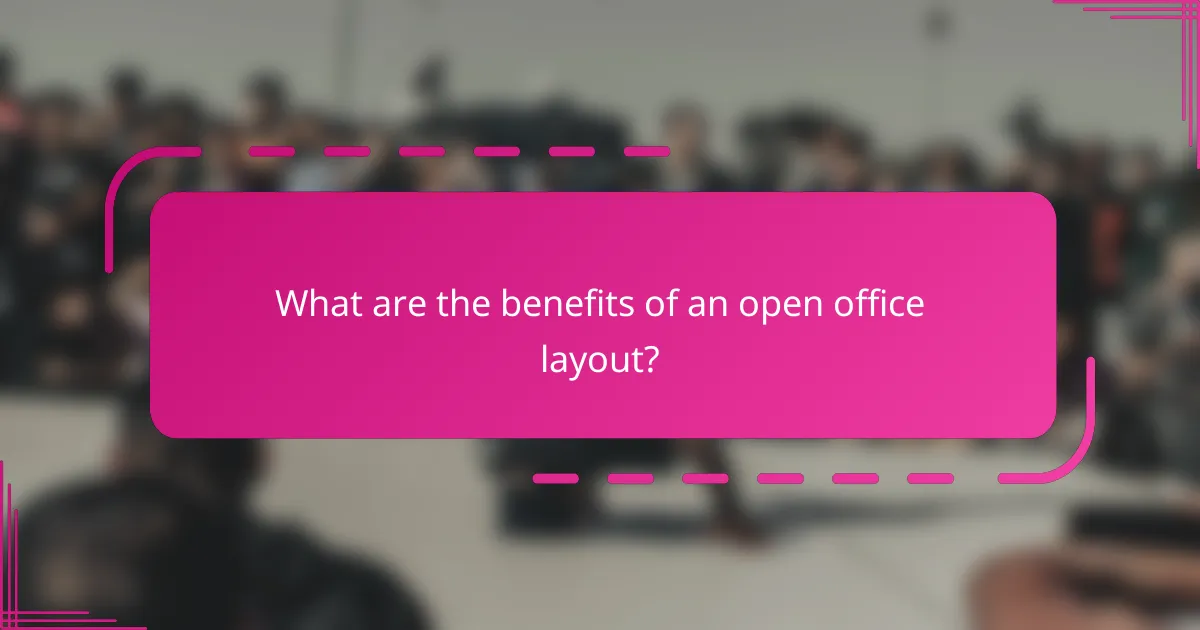
What are the benefits of an open office layout?
An open office layout promotes communication and teamwork while maximizing the use of available space. This design encourages a collaborative environment, enhances natural light, and creates a more spacious feel, making it an appealing choice for modern workplaces.
Encourages collaboration
Open office layouts facilitate interaction among team members, breaking down barriers that traditional cubicles create. This setup allows for spontaneous conversations and brainstorming sessions, which can lead to innovative ideas and solutions.
To maximize collaboration, consider incorporating communal areas or breakout spaces within the open layout. These zones can serve as informal meeting spots, further enhancing teamwork and creativity.
Enhances natural light flow
One of the significant advantages of an open office is the improved flow of natural light. With fewer walls obstructing windows, light can permeate the space, creating a brighter and more inviting atmosphere.
To optimize natural light, position workstations near windows and use light-colored furnishings to reflect brightness. This can reduce the need for artificial lighting, potentially lowering energy costs.
Creates a sense of spaciousness
An open office layout can make a workspace feel larger and more airy. The absence of physical barriers allows for better sightlines and movement, contributing to an overall sense of freedom and flexibility.
When designing an open office, use furniture that is low-profile and modular to maintain this spacious feel. Consider incorporating plants or visual dividers that do not obstruct views but still provide some level of separation.
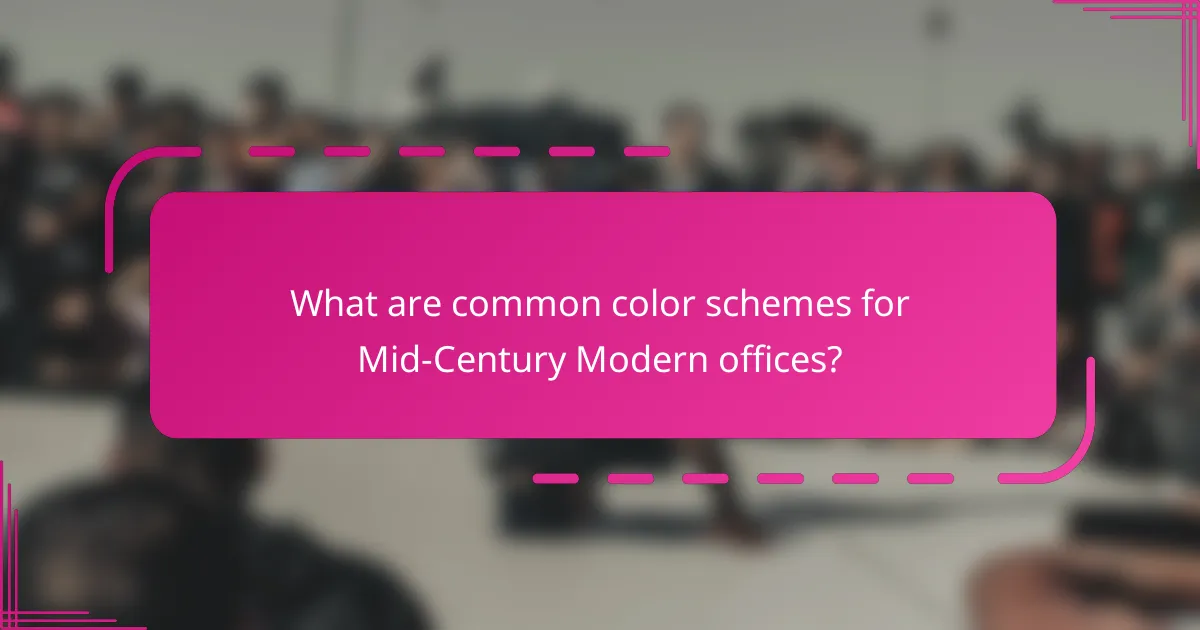
What are common color schemes for Mid-Century Modern offices?
Common color schemes for Mid-Century Modern offices typically feature earthy tones, vibrant accents, and a mix of neutral shades. These palettes often include colors like olive green, mustard yellow, and burnt orange, complemented by whites and browns to create a balanced and inviting atmosphere.
Earthy Tones
Earthy tones are foundational in Mid-Century Modern design, providing a warm and organic feel. Shades such as terracotta, olive green, and muted browns evoke a connection to nature, which is a hallmark of this style. These colors can be used for walls, furniture, or decor to create a cohesive look.
Vibrant Accents
Vibrant accents add a playful touch to Mid-Century Modern offices. Colors like bright orange, teal, and mustard yellow can be incorporated through accessories, artwork, or furniture pieces. These pops of color help to energize the space and can be strategically placed to draw attention to key areas.
Neutral Shades
Neutral shades serve as a backdrop in Mid-Century Modern offices, allowing other colors to stand out. Whites, creams, and light grays are commonly used for walls and larger furniture items. These tones create a sense of openness and can make smaller spaces feel larger and more inviting.
